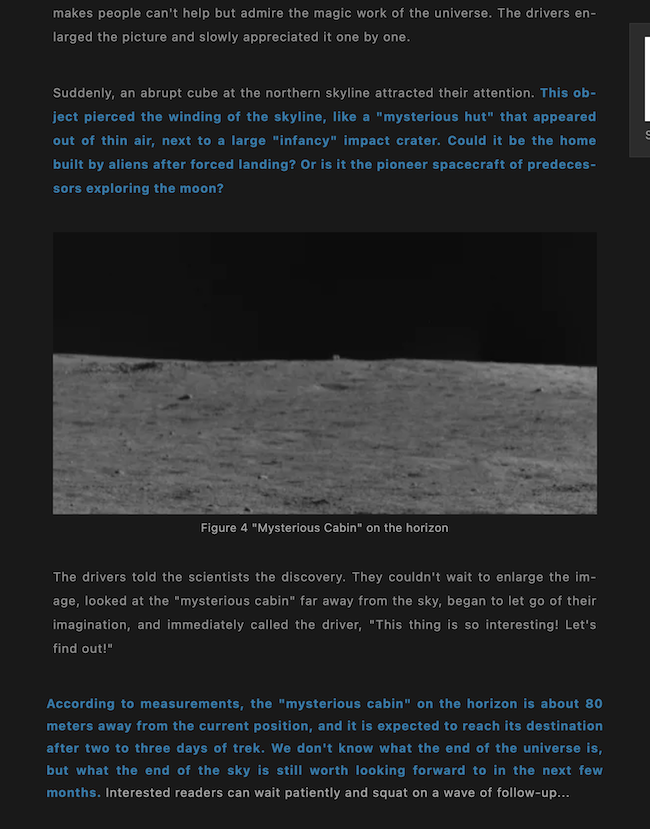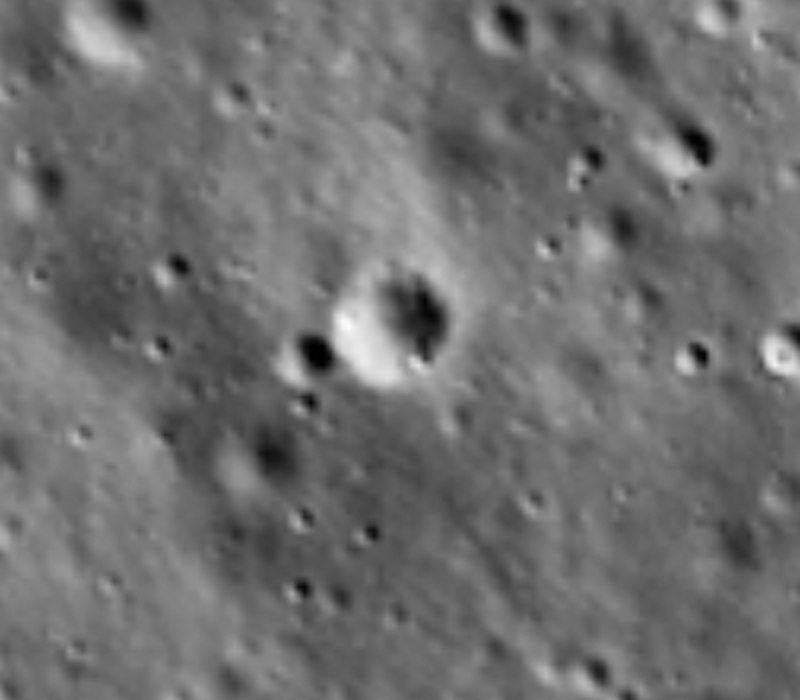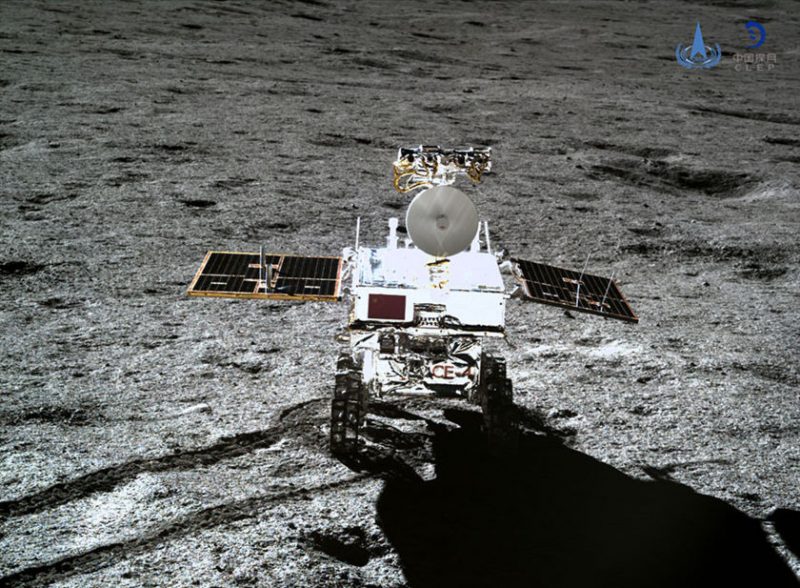
China’s Yutu 2 rover has been crawling across the lunar surface since landing in Von Kármán crater on the far side of the moon on January 3, 2019. On December 3, 2021, it logged a strange entry in its Yutu No. 2 Driving Diary. It spied a cube-shaped object on the horizon and nicknamed it the ‘mystery hut.’ The Chinese website Our Space publishes the diary and is affiliated with the China National Space Administration (CNSA).
Additionally, the media outlet CNET picked up the story on December 5, with Space.com following on December 6.
The 2022 lunar calendars are here. Order yours before they’re gone!
Yutu 2’s ‘mystery hut’: a cube-shaped oddity
CNSA gave the cube the informal nickname of the ‘mystery hut.’ Don’t take it literally that it’s an actual hut. They estimate the cube at approximately 262 feet (80 m) from the rover’s location on its “36th night” at the end of November 2021. It’s perched just inside the edge of a crater almost due north of that location.



Notably, it appears to be roughly cube-shaped, although it is difficult to determine the true shape due to the small size of the object in the image. Right now, it is only a few pixels wide. There seems to be a dark spot in the middle of the object, or it may be two smaller objects close together.
Taking a closer look at the mystery hut
The rover team, of course, wants to get a closer look at the object, and Yutu 2 will now start driving toward it. Rovers on the moon and Mars are slow, however, and it will take about 2-3 lunar days (2-3 Earth months) to get there. A lunar day is the period of time for Earth’s moon to complete one rotation on its axis with respect to the sun. That’s about 27 Earth days, 7 hours, 43 minutes and 12 seconds to complete one orbit.
Space journalist Andrew Jones in Finland also tweeted about the discovery:
Ah. We have an update from Yutu-2 on the lunar far side, including an image of a cubic shape on the northern horizon ~80m away from the rover in Von Kármán crater. Referred to as "????" ("mystery house"), the next 2-3 lunar days will be spent getting closer to check it out. pic.twitter.com/LWPZoWN05I
— Andrew Jones (@AJ_FI) December 3, 2021
He also may have verified the specific location to me on Twitter. The object can possibly be seen in orbital images from NASA’s Lunar Reconnaissance Orbiter (LRO) as a small bright dot on the edge of the crater, almost due north of the rover and about the right distance away. That hasn’t been fully confirmed yet, though.
Yup, it's on the northern horizon and looks to be the block/boulder/bright bit on the crater rim.
— Andrew Jones (@AJ_FI) December 6, 2021
So, what is it?
At this point, it’s hard to tell for sure, but previous moon exploration would suggest it is most likely a large boulder. Such rocky blocks are common, leftover from crater-producing impacts. The cubic shape might be real, or could be partially an artifact of the relatively low resolution of the image. Ultimately, only closer images will show the true identity of the object.
If it did turn out to be something unnatural, that would, obviously, be a game-changer. Searching for ancient relics of alien civilizations is something scientists are starting to take more seriously. Such artifacts could be on the moon, Mars, or any number of asteroids or other objects in the solar system. The SETA project (Search for Extraterrestrial Artifacts), announced earlier this year, also advocates searching for such evidence.

Yutu 2 and Chang’e 4
The Chang’e 4 spacecraft took the Yutu 2 rover to the lunar surface. It landed in the Von Kármán crater on the far side of the moon on January 3, 2019. It’s the fourth Chinese moon mission to date. Yutu 2 is the second Chinese rover to drive on the moon.
In July 2019, Yutu 2 also discovered a gel-like substance that scientists later identified to most likely be glass from a meteorite impact.
With all this in mind, even if the hut turns out to be ‘just’ a boulder, it will still be of great scientific interest to the scientists involved. Such pieces of lunar real estate can provide valuable clues about the moon and its geological history.

Bottom line: China’s Yutu 2 rover on the far side of the moon has spotted a roughly cube-shaped object on the horizon. What is Yutu 2’s ‘mystery hut’?
Via Yutu No. 2 Driving Diary (translated from Chinese)
The post ‘Mystery hut’ on the far side of the moon first appeared on EarthSky.
from EarthSky https://ift.tt/3pNRk1J

China’s Yutu 2 rover has been crawling across the lunar surface since landing in Von Kármán crater on the far side of the moon on January 3, 2019. On December 3, 2021, it logged a strange entry in its Yutu No. 2 Driving Diary. It spied a cube-shaped object on the horizon and nicknamed it the ‘mystery hut.’ The Chinese website Our Space publishes the diary and is affiliated with the China National Space Administration (CNSA).
Additionally, the media outlet CNET picked up the story on December 5, with Space.com following on December 6.
The 2022 lunar calendars are here. Order yours before they’re gone!
Yutu 2’s ‘mystery hut’: a cube-shaped oddity
CNSA gave the cube the informal nickname of the ‘mystery hut.’ Don’t take it literally that it’s an actual hut. They estimate the cube at approximately 262 feet (80 m) from the rover’s location on its “36th night” at the end of November 2021. It’s perched just inside the edge of a crater almost due north of that location.



Notably, it appears to be roughly cube-shaped, although it is difficult to determine the true shape due to the small size of the object in the image. Right now, it is only a few pixels wide. There seems to be a dark spot in the middle of the object, or it may be two smaller objects close together.
Taking a closer look at the mystery hut
The rover team, of course, wants to get a closer look at the object, and Yutu 2 will now start driving toward it. Rovers on the moon and Mars are slow, however, and it will take about 2-3 lunar days (2-3 Earth months) to get there. A lunar day is the period of time for Earth’s moon to complete one rotation on its axis with respect to the sun. That’s about 27 Earth days, 7 hours, 43 minutes and 12 seconds to complete one orbit.
Space journalist Andrew Jones in Finland also tweeted about the discovery:
Ah. We have an update from Yutu-2 on the lunar far side, including an image of a cubic shape on the northern horizon ~80m away from the rover in Von Kármán crater. Referred to as "????" ("mystery house"), the next 2-3 lunar days will be spent getting closer to check it out. pic.twitter.com/LWPZoWN05I
— Andrew Jones (@AJ_FI) December 3, 2021
He also may have verified the specific location to me on Twitter. The object can possibly be seen in orbital images from NASA’s Lunar Reconnaissance Orbiter (LRO) as a small bright dot on the edge of the crater, almost due north of the rover and about the right distance away. That hasn’t been fully confirmed yet, though.
Yup, it's on the northern horizon and looks to be the block/boulder/bright bit on the crater rim.
— Andrew Jones (@AJ_FI) December 6, 2021
So, what is it?
At this point, it’s hard to tell for sure, but previous moon exploration would suggest it is most likely a large boulder. Such rocky blocks are common, leftover from crater-producing impacts. The cubic shape might be real, or could be partially an artifact of the relatively low resolution of the image. Ultimately, only closer images will show the true identity of the object.
If it did turn out to be something unnatural, that would, obviously, be a game-changer. Searching for ancient relics of alien civilizations is something scientists are starting to take more seriously. Such artifacts could be on the moon, Mars, or any number of asteroids or other objects in the solar system. The SETA project (Search for Extraterrestrial Artifacts), announced earlier this year, also advocates searching for such evidence.

Yutu 2 and Chang’e 4
The Chang’e 4 spacecraft took the Yutu 2 rover to the lunar surface. It landed in the Von Kármán crater on the far side of the moon on January 3, 2019. It’s the fourth Chinese moon mission to date. Yutu 2 is the second Chinese rover to drive on the moon.
In July 2019, Yutu 2 also discovered a gel-like substance that scientists later identified to most likely be glass from a meteorite impact.
With all this in mind, even if the hut turns out to be ‘just’ a boulder, it will still be of great scientific interest to the scientists involved. Such pieces of lunar real estate can provide valuable clues about the moon and its geological history.

Bottom line: China’s Yutu 2 rover on the far side of the moon has spotted a roughly cube-shaped object on the horizon. What is Yutu 2’s ‘mystery hut’?
Via Yutu No. 2 Driving Diary (translated from Chinese)
The post ‘Mystery hut’ on the far side of the moon first appeared on EarthSky.
from EarthSky https://ift.tt/3pNRk1J

Aucun commentaire:
Enregistrer un commentaire